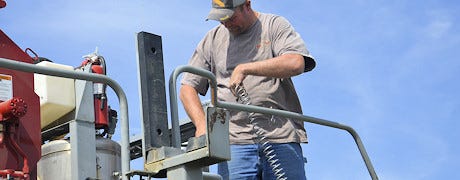
Clint Arnholt did his homework before he decided how to rig up his Hagie sprayer with a Valmar seeder to distribute cover crop seed on a timely basis in both corn and soybeans. Once he decided how he wanted to do it, it took himself and a partner just a few days to make the conversion and work out the bugs.
“Next time we should be able to switch it much faster,” Arnholt says. “We were doing this on our own and we had to figure out how to make things fit and worked. It wasn’t that difficult-it just took time.”

LEARN THE CONVERSION: Clint Arnholt says it should be easier to switch from sprayer to seeder now that they have the bugs worked out of the process.
It wasn’t difficult for Arnholt, Columbus, because he is mechanically inclined. If you’re not good with a wrench or thinking intuitively about how to alter things to make them work, converting a sprayer to seed cover crops and then back to a sprayer again could be a nightmare.
Arnholt bases much of his farming income on custom work, applying lime and other products, and soil sampling and mapping for other farmers. Now he’s wondering if there might be a niche need for someone to install seeders on sprayers for other farmers who want to try it in the future.
Part of that may depend upon how cover crops fare this year. A lot of cover crops have been seeded, particularly in certain areas of the state where a soil and water conservation district, seed dealer or farmer is pushing the concept. If the cover crops perform well and farmers can kill them on time and get their regular crop planted normally next spring, the interest in cover crops might grow even more.
Seeding from a ground applicator like a sprayer lets you be timely. The sprayer needs to have lots of clearance for it to work seeding cover crops.
About the Author(s)
You May Also Like




